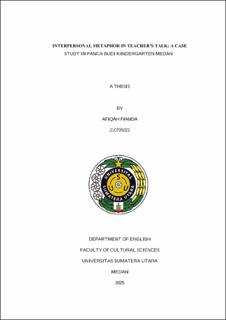| dc.description.abstract | This study investigates the use of interpersonal metaphors in teacher talk at Panca Budi
Kindergarten in Medan from the perspective of Systemic Functional Linguistics (SFL).
The research focuses on how teachers use interpersonal metaphors in their classroom
conversations to shape communication, guide interactions, and enhance student
engagement. The main issue addressed in this study is how interpersonal metaphors are
employed in teacher talk at Panca Budi Kindergarten and their impact on classroom
dynamics. The aim of this study is to explore the use of interpersonal metaphors in
teacher talk in the classroom at Panca Budi Kindergarten, based on Michael Halliday
(1960) that focused on using various mood forms in declarative, imperative, and
interrogative sentences. This study seeks to uncover how these metaphors are used to
promote collaboration, assert authority, and encourage student participation in the
learning process. The study adopts a qualitative approach, analyzing data collected
through classroom observations and audio recordings. The data were analyzed using
the Systemic Functional Linguistics (SFL) perspective to understand the use of
interpersonal metaphors in teacher talk. The analysis includes identifying and
classifying sentence forms in declarative, imperative, and interrogative moods, as well
as the frequency of metaphor use. The results show that teachers strategically employ
interpersonal metaphors to promote collaboration, assert authority, and encourage
student participation, creating a more dynamic and inclusive classroom environment.
The analysis of the data reveals five instances of metaphorical coding. Four of these
are metaphorical coding of commands executed in the interrogative mood, and one is
a metaphorical coding of a statement executed in the imperative mood. These findings
indicate that the teacher's communication style is primarily focused on providing clear
and direct instructions, yet it also reflects the use of metaphorical language in their
interactions. | en_US |


